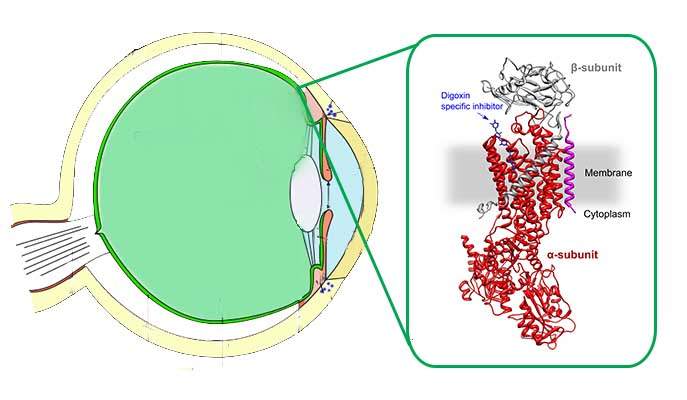Are you a journalist? Please sign up here for our press releases
Subscribe to our monthly newsletter:
Glaucoma, a group of eye diseases affecting millions of people, is a leading cause of blindness around the world. Weizmann Institute scientists, in collaboration with ophthalmologists, have now developed a new compound that may help treat glaucoma by combating its major symptom: the buildup of pressure in the eye.

The eye’s cornea and lens are bathed by a watery fluid called aqueous humor, which is continuously produced within the eye and drains back into general circulation. In glaucoma, eye pressure rises because this fluid is not drained properly or is produced in excessive amounts. One of the mechanisms regulating the production of aqueous humor is an enzyme called the sodium-potassium pump, which is found in the membranes of cells. As its name suggests, this enzyme “pumps” ions – transporting sodium out of the cell and bringing in potassium. The pump creates a flow of sodium and other ions, accompanied by an influx of water, into the frontal chamber of the eye. The Weizmann Institute of Science’s new compound reduces pressure in the eye by inhibiting the activity of this pump and, consequently, the production of the aqueous humor.
Creating such an interference with the working of the sodium-potassium pump is far from straightforward. Because these pumps are present in virtually all cells and tissues, interfering with their work is liable to affect not just the regulation of eye pressure but a host of other vital processes, leading to toxic side effects. That, in fact, is the limitation of digoxin, the classic blocker of the sodium-potassium pump. This foxglove plant extract has been in medical use for more than two hundred years, primarily to stimulate contractions of the heart muscle, but safety concerns prevent its use for treatment of glaucoma.

As reported recently in the Proceedings of the National Academy of Sciences (PNAS), USA, the Weizmann Institute’s new compound is derived from digoxin, but it has been designed to target a particular variant of the sodium-potassium pump that is located in the eye. It is applied to the eye in drops, thereby avoiding side effects in the body.
“We were able to develop the new compound thanks to the unique combination of skills in our team, including expertise in molecular biology and enzymology of the sodium-potassium pump, organic chemical syntheses and physiological measurements of intraocular pressure,” said team leader Prof. Steven Karlish of the Biomolecular Sciences Department. Team member Dr. Adriana Katz is an expert on membrane proteins; before joining Karlish’s lab, she conducted research on Dunaliella alga for many years. Dr. Daniel Tal brings to the team four decades of expertise in chemical syntheses and purification, particularly of steroids such as digoxin and its derivatives. The team also included PhD student Michael Habeck and Dr. Efrat Ben Zeev of the Weizmann Institute’s Nancy and Stephen Grand Israel National Center for Personalized Medicine. The scientists worked in close collaboration with ophthalmologists: Drs. Yaniv Bar Kana and Dan Heller of the Assaf Harofeh Medical Center and Drs. Arie Marcovich and Bilal Rabah of the Kaplan Medical Center.
Dr. Katz said: “The sodium-potassium pump has two major subunits, alpha and beta, each of which comes in several variants, characteristic of different tissues. In the eye cells that produce the aqueous humor, the pump is made up of two particular units: alpha-2 and beta-3.” Dr. Tal added: “We synthesized dozens of digoxin derivatives before finally choosing one that was particularly effective in blocking the alpha-2-beta-3 type of the pump but not others, so that the activity of our compound is directed mainly to the eye.”
When given in combination with this drug, our derivative produced an effect that lasted twenty-four hours
Dr. Katz elaborated further on the study’s results: “In experiments with rabbits, our digoxin derivative was more effective in preventing or reducing eye pressure than the most widely used glaucoma drug. Moreover, when given in combination with this drug, our derivative produced an effect that lasted twenty-four hours. This is a major advantage because taking a drug only once a day eases its use and is a particularly important consideration for the patients.”
Yeda Research and Development Company, the Weizmann Institute’s technology transfer arm, has filed two patents on the new digoxin compounds. The need for new glaucoma drugs is great because existing drugs do not work in all patients, and even when they do, they can lose their effectiveness over time, leading to the need for surgical intervention.
Steve Karlish's research is supported by the Pomeraniec-Sagov Renal Research Fund; and the Mauerberger Foundation Fund.